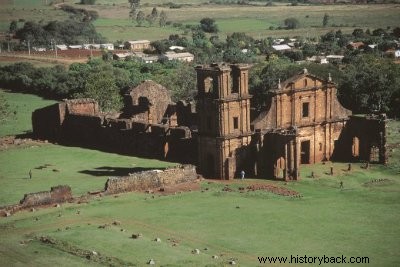The Sete Povos das Missões region resulted from the Spanish government's strategy for the colonization of the Rio de la Plata region, in Spanish America.
Location
The regions were formed by São Francisco Borja, founded in 1682, São Nicolau (1687) and São Luiz Gonzaga (1687). They were also integrated by:São Miguel Arcanjo (1687), São Lourenço Mártir (1690), São João Batista (1697) and Santo Ângelo Custódio (1707).

The missions, also called reductions, were founded and organized by priests of the Society of Jesus. The 30 reductions occupied the current territories of Brazil, Paraguay, Argentina and Uruguay. In these missions there were Indians of different ethnicities, but the majority were Guarani.
The Guarani Indians were the first to feel the European impact with the arrival of Spanish Jesuit priests in 1626.
The Jesuits arrived in the region with the aim of catechizing and "civilizing" under Spanish authority. The permanence, however, was conflicting. During the 17th century, battles between pioneers and indigenous people were common.
The conflicts were marked by the destruction of the missions and the first exodus of the Guarani. In periods of peace, the indigenous people returned to their place of origin with the support of the Jesuits.
Among the challenges of the Jesuit priests were convincing the Indians that they needed to be sedentary and monogamous. The Guarani are nomadic and polygamous. Furthermore, they are polytheists.
Some groups still practiced cannibalism in funeral ceremonies until the beginning of colonization.
The missions suffered successive attacks, mainly by slave traders. As a strategy to free the Indians, in 1818, the Jesuits proposed that the Indians become vassals of the king.
The Indians also received military training. The strategy was applied because the area was not clearly demarcated and was the subject of dispute between the Portuguese and Spanish crowns.
There were two types of missions. The eastern missions were in the territories east of the Uruguay River, in the region that today borders Brazil. The western missions were in the region that is now occupied by Argentina, on the banks of the Paraná and Paraguay rivers.
At its peak, the Sete Povos das Missões region held 30,000 people. All were indigenous, but the Spanish priests were the administrators.
Read Also :
- Company of Jesus - Jesuit Order
- Indigenous Slavery in Colonial Brazil
- Guarani Indians
- Rio Grande do Sul
Treaty of Madrid
The permanence of the missions was at the center of successive territorial disputes between Portugal and Spain.
The conflicts started in 1680 and lasted until 1750, when the Treaty of Madrid was signed. The agreement redefined the possession of the territory. It predicted that Spain would hand over the region of Sete Povos das Missões.
Portugal would hand over the area of the province of Sacramento, in Argentina.
Learn more about the Madrid Treaty.
Guaranitic War
The indigenous people were against the terms of the treaty and did not accept to leave the territory. In 1754, when Portugal took possession of the region, it had the help of the Spanish army to enforce the provisions of the agreement.
In the fight against the indigenous, 20 thousand indigenous people died.
Treaty of Saint Ildefonso
The Treaty of Santo Ildefonso was signed on October 1, 1777 between Portugal and Spain as a way of revalidating the Treaty of Madrid.
The signing of the agreement ended the dispute between the two countries over the colony of Sacramento. Under the agreement, the Spaniards maintained the colony and region of the Seven Peoples of the Missions. They returned Santa Catarina to the Portuguese and recognized Portuguese sovereignty over the left bank of the Rio de la Plata.
Curiosities
The governmental management of the missions followed the organization of Spanish cities. Each had a superior chief and there were mayors and councilors. Both formed a council. All positions were held by indigenous people.
In the social organization imposed by the Jesuits, there was no private property. The tools for working the land were for collective use.
Under the command of the religious, the indigenous people learned to handle the land, raise animals and carve wood. Society was divided into classes according to craft and artists had nobility status.
The Portuguese Crown allowed indigenous slavery, while the Spanish Empire automatically made them subjects of the king
The missions were constantly attacked by pioneers looking for slaves for the colonies
Tourism
The municipalities of Rio Grande do Sul that make up the region where the Sete Povos das Missões were located are a constant target for tourists.
In the regions, tourism companies and the municipal executive promote tours in the so-called "Mission Routes". The objective is to retrace the path of the indigenous people, promote the contemplation of nature and visit archaeological sites.
Film Tip
The film "A Missão" is among the main works that highlight the effects of the dispute between Portuguese and Spanish over the territory of Sete Povos das Missões.
The English work portrays the drama of the indigenous people who fled from Portuguese slavery and remained at the center of the territorial battle. Directed by Roland Joffé, it was released in 1986.
Documentary Tip
In 2013, the Federal Senate released the documentary "Jesuit Missions - Warriors of Faith". Divided into three parts, the documentary features experts who analyze the effects of the presence of Society of Jesus priests in the region.
Want to know more about this topic? Read :
- Treaty of Utrecht
- Treaty of Madrid
- Entries and Flags
- Formation of the Brazilian territory
- Cultural Heritage
